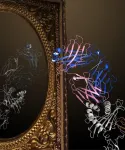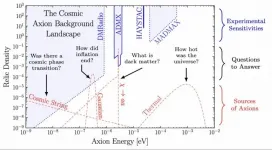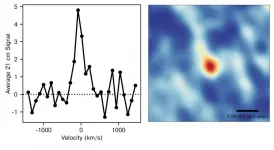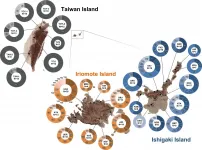Monash researchers make fundamental advance in understanding T cell immunity
2021-06-07
(Press-News.org) Monash University researchers have provided a fundamental advance regarding how T cells become activated when encountering pathogens such as viruses.
The recent study published in Science, co-led by Professor Nicole La Gruta, Professor Jamie Rossjohn and Professor Stephanie Gras with first author Dr Pirooz Zareie from the Monash Biomedicine Discovery Institute, have found that T Cells need to recognise pathogens in a particular orientation in order to receive a strong activating signal.
T cells play a key role in the immune system by eliminating invading pathogens, such as viruses, and it is crucial to understand the factors that determine how and why T cells become activated after recognizing these pathogens.
T cells express on their surface a T cell receptor (TCR) that recognizes and binds to virus fragments (antigens) presented by infected cells. This recognition event can lead to T cell activation and killing of infected cells.
"The central issue is that there are millions of different T cell receptors (TCRs) in the human body, and a vast array of viruses, making it difficult to understand the rules around how T cell receptor recognition of a virus drives T cell activation. Indeed, it is a problem that has remained contentious for over 25 years" says Professor La Gruta.
"Our study has shown that the orientation in which the T cell receptor binds is a primary factor determining whether the T cell receives an activating signal," Professor La Gruta said.
"This is an advance in our fundamental understanding of how a T cell needs to 'see' pathogenic antigens in order to be activated," she said. "It has clarified a critical mechanism essential for effective T cell immunity. It is also relevant to the ongoing development of immunotherapies that aim to boost the activation of T cells."
Dr Pirooz Zareie stated: "a combination of technologies, including super-resolution microscopy, X-ray crystallography at the Australian Synchrotron, biochemical assays and using in vitro and in vivo experimental models from a variety of labs led to the findings."
The study represented a cross-disciplinary collaboration between researchers from the University of Utah, National University of Singapore, University of New South Wales and Monash University.
INFORMATION:
Read the full paper in Science titled: Canonical T cell Receptor Docking on peptide-MHC is essential for T cell signaling.
DOI: 10.1126/science.abe9124
About the Monash Biomedicine Discovery Institute at Monash University
Committed to making the discoveries that will relieve the future burden of disease, the newly established Monash Biomedicine Discovery Institute at Monash University brings together more than 120 internationally-renowned research teams. Spanning six discovery programs across Cancer, Cardiovascular Disease, Development and Stem Cells, Infection and Immunity, Metabolism, Diabetes and Obesity, and Neuroscience, Monash BDI is one of the largest biomedical research institutes in Australia. Our researchers are supported by world-class technology and infrastructure, and partner with industry, clinicians and researchers internationally to enhance lives through discovery.
For Media Enquiries please contact:
Wendy Smith - Monash Communications Manager
E: wendy.smith1@monash.edu
T: +61 (0) 425 725 836
For more Monash media stories, visit our news and events site
[Attachments] See images for this press release:

ELSE PRESS RELEASES FROM THIS DATE:
2021-06-07
When we inhale isolated coronavirus particles, more than 65% reach the deepest region of our lungs where damage to cells can lead to low blood oxygen levels, new research has discovered, and more of these aerosols reach the right lung than the left.
Lead author of the study Dr Saidul Islam, from the University of Technology Sydney, said while previous research has revealed how virus aerosols travel through the upper airways including the nose, mouth and throat - this study was the first to examine how they flow through the lower lungs.
"Our ...
2021-06-07
Finding the hypothetical particle axion could mean finding out for the first time what happened in the Universe a second after the Big Bang, suggests a new study published in Physical Review D on June 7.
How far back into the Universe's past can we look today? In the electromagnetic spectrum, observations of the Cosmic Microwave Background -- commonly referred to as the CMB -- allow us to see back almost 14 billion years to when the Universe cooled sufficiently for protons and electrons to combine and form neutral hydrogen. The CMB has taught us an inordinate amount about the evolution of the cosmos, but photons in the CMB were released 400,000 years after the Big Bang making it extremely challenging to learn about the history of ...
2021-06-07
TAMPA, Fla. (June 4, 2021) — Type 1 diabetes (T1D) is an autoimmune disease in which a misdirected immune system gradually destroys healthy pancreatic islet β cells, resulting in a lack of insulin. The exact cause of T1D remains unknown. However, β cell-reactive autoantibodies can be detected in circulating blood months to years before diagnosis, raising the possibility of intervening to stop or delay T1D before children develop the disease.
Monitoring the number, type, and concentration of autoantibodies appearing in the blood can help predict the long-term risk of progression from autoimmunity to symptomatic T1D.
Now new findings suggest that measuring how patterns ...
2021-06-07
A research team from the University of Copenhagen and University of Helsinki demonstrates it is possible to predict individual preferences based on how a person's brain responses match up to others. This could potentially be used to provide individually-tailored media content -- and perhaps even to enlighten us about ourselves.
We have become accustomed to online algorithms trying to guess our preferences for everything from movies and music to news and shopping. This is based not only on what we have searched for, looked at, or listened to, but also on how these activities compare to others. Collaborative filtering, as the technique is called, uses hidden ...
2021-06-07
A team of astronomers from the National Centre for Radio Astrophysics (NCRA-TIFR) in Pune, and the Raman Research Institute (RRI), in Bangalore, has used the Giant Metrewave Radio Telescope (GMRT) to measure the atomic hydrogen gas content of galaxies 9 billion years ago, in the young universe. This is the earliest epoch in the universe for which there is a measurement of the atomic hydrogen content of galaxies. The new result is a crucial confirmation of the group's earlier result, where they had measured the atomic hydrogen content of galaxies 8 billion years ago, and pushes our understanding of galaxies to even earlier in the universe. ...
2021-06-07
Decades of research has revealed the remarkable morphological adaptations of sea snakes to aquatic life, which include paddle-shaped tails, salt-excreting glands, and the ability to breathe through their skin.
In a new study published in Biological Journal of the Linnean Society, researchers at the University of Adelaide detail the enlarged touch receptors that evolved in male turtle-headed sea snakes (Emydocephalus annulatus), to help them locate and court females in aquatic environments.
Lead author, Jenna Crowe-Riddell, PhD graduate at the University of Adelaide's School of Biological Sciences, says on land, snakes use tongue-flicking ...
2021-06-07
Older people need digital skills training to learn to use digital technology more independently, but they also seek digital training opportunities because of the social benefits they offer, according to a recent study from the University of Eastern Finland. Published in International Journal of Lifelong Education, the study examined perceived benefits of digital skills training among older adult learners, their teachers and peer tutors. Data for the study were collected in liberal adult education organisations, such as community colleges, as well as in peer tutoring sessions organised by third sector actors.
New skills and friendships
The coronavirus pandemic has, for its part, highlighted inequalities in the availability and ...
2021-06-07
The Amami, Okinawa region of Japan may be designated a World Heritage Site in July of 2021 based on the recent recommendation from the IUCN. The Iriomote wild cat is a symbolic species of the region, having evolved independently on the island. The area is home to many other highly endemic and unique evolutionary species. A research group comprised mostly of former students of Professor Koji Tojo's Faculty of Science lab of Shinshu University focused on the study of dragonflies, continuing from their previous study of their comparative embryogenesis. About 5,000 species of insects belonging to 26 families of the order Dragonfly are known ...
2021-06-07
A long-standing basic question in biology relates to how life satisfies the fundamental constraints put on it by physics and chemistry. Darwin's warm pond hypothesis for the origin of primordial cells is a familiar one. Advances have been made in mapping out the organic molecules that likely existed on the early Earth, and recently candidate prototypic pathways in early cells have been formulated. But how did these candidates' early biochemistry actually function as a system, on which subsequent cellular life is based?
A team of bioengineers at the Novo Nordisk Foundation Center for Biosustainability, DTU, has now defined ten overarching classes of constraints on early metabolic ...
2021-06-07
A minimally-invasive procedure that targets the nerves near the kidney has been found to significantly reduce blood pressure in hypertension patients, according to the results of a global multicentre clinical trial led in the UK by researchers at Queen Mary University of London and Barts Health NHS Trust.
The study, published in The Lancet and presented at the American College of Cardiology meeting, suggests that the procedure could offer hope to patients with high blood pressure who do not respond to recommended treatments (resistant hypertension), and are at greatly increased risk of cardiovascular diseases, including stroke and heart attack.
The international clinical trial tested a one-hour procedure called 'renal denervation', which uses ultrasound energy to ...
LAST 30 PRESS RELEASES:
[Press-News.org] Monash researchers make fundamental advance in understanding T cell immunity





